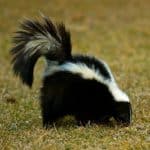Votre panier est actuellement vide !

The skunk
A small mammal with a black coat and two white stripes on its back.It has a large tail in the shape of a feather duster.Its weight varies from one to 5.3 kilograms.It has a powerful jaw and long, sharp claws.When threatened, the skunk throws a very foul-smelling liquid, spraying those who scare it. This liquid can cause nausea and temporary blindness. The range of the liquid is about five meters, but the smell is felt much further away.
Latin Name: Mephitis mephitis
Description:Small mammal.Its coat is black, but it has two white stripes on the back.It has a large tail in the form of a feather duster.Its weight varies from one to 5.3 kilograms.It has a powerful jaw and long sharp claws.When threatened, the skunk throws a very smelly liquid, drenching those who scare it. This liquid can cause nausea and temporary blindness. The liquid is projected through the channels of its anal glands.The range of the liquid is about five meters, but the smell is felt much farther.
Reproduction:The female has only one litter per year and each litter has from 2 to 10 young that mature in about six months. Since humans are the skunk’s only true predator, it is easy to observe the young playing without fear even near homes.
Habits:The skunk is mostly active at night and rests during the day. It is a solitary animal that eats everything: insects, seeds, fruits, nuts, plants, small mammals, birds, reptiles and particularly appreciates waste.Skunks usually occupy burrows abandoned by groundhogs, foxes or other mammals of similar or larger size and rarely dig their own burrows. They will also use stumps, rock piles or piles of garbage; they may even take up residence under a house, under a veranda or in a cellar.This last habit is particularly common in agricultural areas.When the skunk digs its own burrow, it is usually rudimentary, but when it inherits that of another animal, it may be very sophisticated. There may be from one to five well-concealed openings that lead to a whole system of tunnels and chambers. One of these, lined with leaves, serves as a nest. Leaves can also be used to cover the burrow openings in cold weather. Skunks may leave their burrows at any time of the day in search of food, but they usually leave in the late afternoon or early evening for the night. They forage within a radius of about 800 m, and may venture up to 2 km from their burrow in one night. With a thick layer of fat on in the fall, the skunk chooses a deep burrow in November or December where it will spend the winter. As many as 20 skunks have been found in a single shelter, but there are usually far fewer. The male remains active until the temperature reaches about 10°C below zero, at which time he may join his own family or other males, or even burrow alone. He may leave his den briefly at any time during the winter. The same den may contain males and females, young and old. In late February, in some parts of Canada, the animal begins to emerge from its winter slumber and is fully active by late March. The skunk’s only natural predators are bobcats, foxes, coyotes, wolverines and cougars.
Prevention:Since the skunk doesn’t have many natural predators, it isn’t afraid of much and often finds itself in the same environments as humans.
What you need to know:If you encounter a skunk? First, she will try to walk away. But if it is very frightened and escape is not possible, it will warn you by raising its tail.If you ignore this warning, the skunk will start tapping its foot.If this audible warning has no effect, it raises its back and pretends to attack. If the warning is still not enough of a deterrent, it will arch its back and spray its opponent in the eyes. The smell is extremely powerful and will last for two weeks, so we recommend that you listen to its warnings and move away immediately, and quietly, to observe this animal from a little further away.If a skunk or a family of skunks has taken up residence in your home or near your home, we recommend that you call in pest management experts to trap and relocate them. Beware, these animals are not easy to catch and you are putting yourself in serious danger if you attempt to trap them yourself.